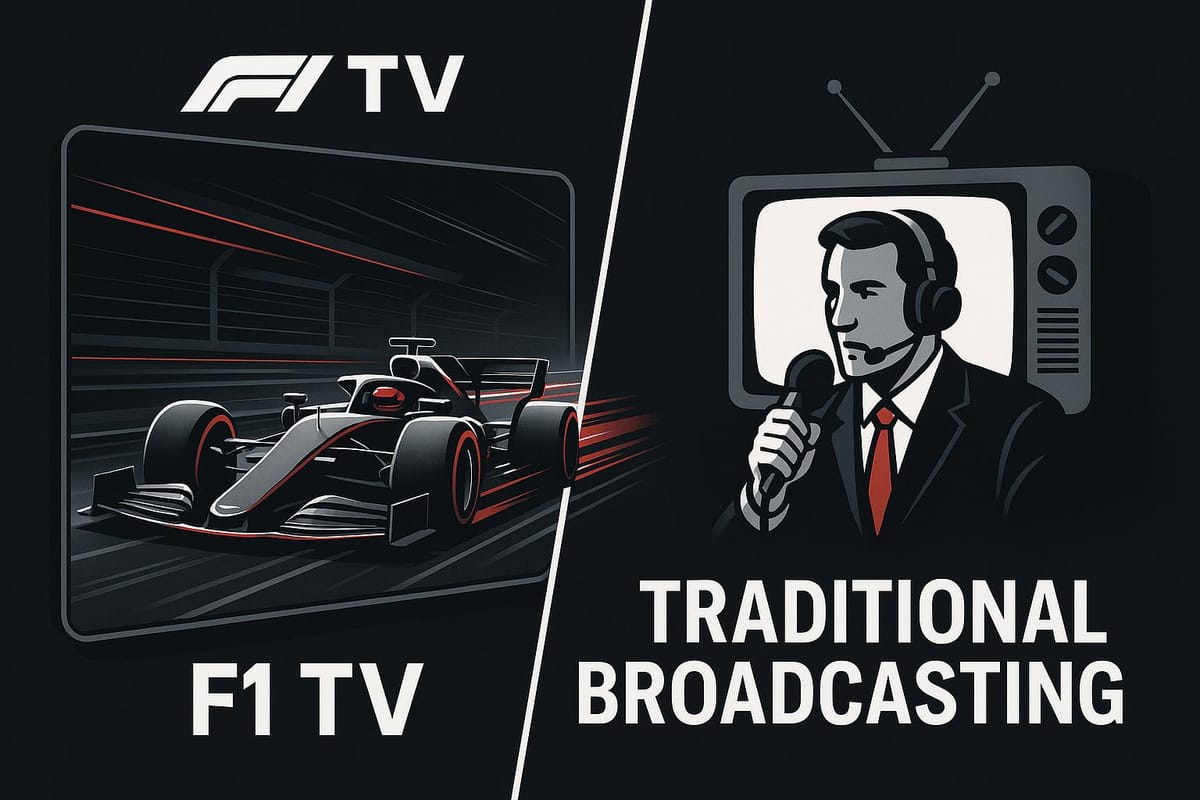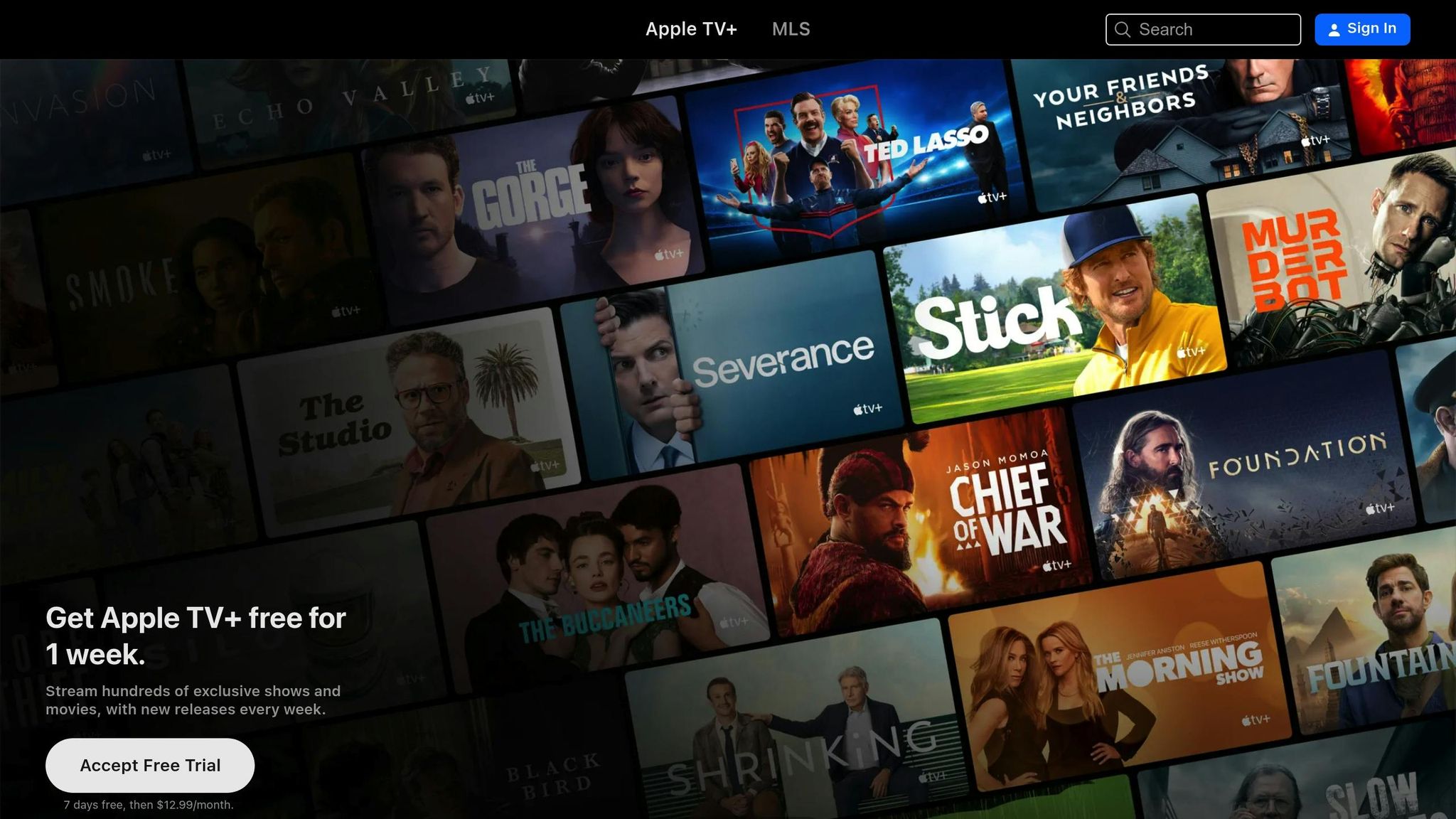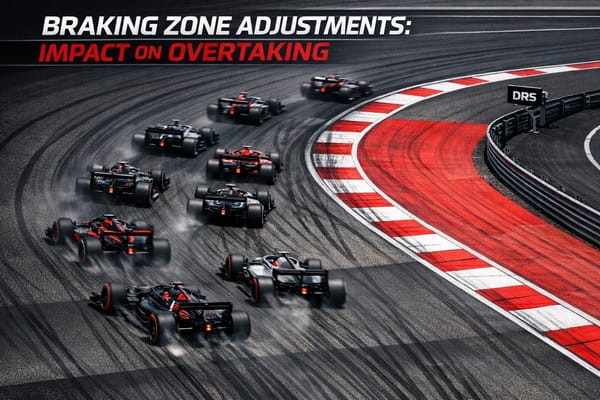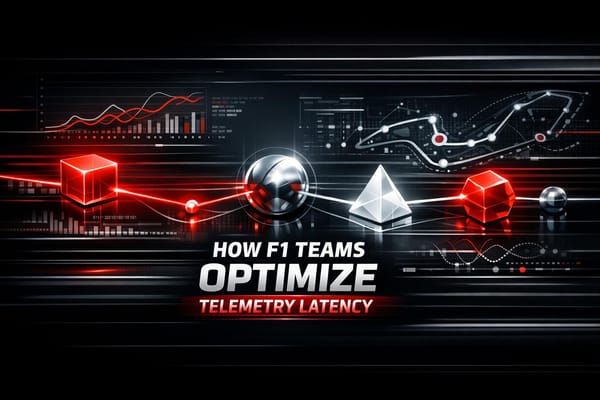F1 TV vs Traditional Broadcasting
Explore the differences between F1 TV and traditional broadcasting, from viewer experience to accessibility and revenue models.

F1 TV and traditional broadcasts offer two very different ways to watch Formula 1, catering to distinct fan preferences.
- F1 TV is a subscription-based streaming service ($84.99/year for Pro) designed for diehard fans. It provides features like live onboard cameras, team radio, telemetry, and race replays. It’s perfect for those who want control over their viewing experience and access to detailed race data.
- Traditional broadcasting through networks like ESPN is included in many cable packages and appeals to casual viewers. It offers polished commentary, curated race coverage, and ease of access but includes commercial breaks.
If you’re tech-savvy and want a deep dive into the sport, F1 TV is for you. If you prefer a simpler, no-setup option, stick with cable. Both formats coexist to meet the needs of a growing U.S. audience.
Quick Comparison:
| Feature | F1 TV Pro ($84.99/year) | ESPN (Cable) |
|---|---|---|
| Onboard Cameras | 20 live streams | Limited clips |
| Team Radio | Uncensored | Selected snippets |
| Telemetry & Data | Detailed | Basic graphics |
| Setup Requirements | App + account | TV channel tuning |
| Commercial Interruptions | None | Frequent |
| Accessibility | Internet required | Cable/Satellite required |
Your choice depends on whether you value customization or simplicity.
How to Watch F1 on Apple TV (F1 TV or ESPN App Setup Guide)

Accessibility and Audience Reach
F1 TV and traditional broadcasting appeal to different types of Formula One fans, each with unique preferences and technical needs. These platforms differ in their ability to reach audiences, shaped by factors like setup requirements, geographic availability, and the type of viewer they attract.
Traditional Broadcasting: Broad Reach and Easy Access
Traditional broadcasters are the go-to choice for reaching large audiences, even in areas where internet access is limited. Thanks to cable or satellite subscriptions, fans in remote or rural regions can follow the races without worrying about broadband speed or availability.
One of the biggest strengths of traditional broadcasting is its simplicity. All you need is a cable or satellite connection - no apps, no accounts, no complicated setups. Many broadcasters also simulcast races on secondary channels, making it easier to cater to viewers in different languages or with specific demographic needs. However, one downside is the inevitable commercial breaks, which can interrupt key moments of the race.
F1 TV: A Tailored Experience for Tech-Savvy Fans
In contrast, F1 TV focuses on fans who want a more interactive and customizable experience. As a direct-to-consumer streaming service, it provides features like multiple camera angles and on-demand content, but it comes with its own set of challenges. High-speed internet is a must, which can limit access for fans in areas with poor broadband infrastructure.
F1 TV works on a wide range of devices, from smartphones and tablets to smart TVs and gaming consoles. This flexibility means you can catch a race on the go or enjoy it on a big screen at home. However, the setup process - downloading the app, creating an account, and configuring devices - can be a hurdle for less tech-savvy users.
Another limitation is geographic availability. In regions where local broadcasters hold exclusive rights, F1 TV may not offer live race streaming. Add to that the separate subscription fee, and it’s clear why some casual fans might stick with traditional TV, especially if they already have access through their cable packages.
Comparison Table: Accessibility and Reach
| Factor | Traditional Broadcasting | F1 TV |
|---|---|---|
| Household Reach | Broad, widely accessible | Limited by internet and regional rights |
| Technical Requirements | TV with cable/satellite service | High-speed internet and compatible devices |
| Setup Complexity | Simple channel tuning | App download, account setup, device configuration |
| Geographic Availability | Nationwide in the U.S. | Limited in some regions due to rights |
| Cost Accessibility | Included in cable packages | Requires separate subscription |
| Target Demographic | General audience | Tech-savvy, dedicated fans |
| Rural Accessibility | High, thanks to satellite | Depends on broadband availability |
| Multi-device Flexibility | Limited to TV | Broad device compatibility |
These differences in accessibility and audience reach highlight the unique appeal of each platform, setting the stage for a deeper dive into their features and overall user experience.
Features and User Experience
The way fans experience Formula 1 through F1 TV and traditional broadcasting couldn’t be more different. It’s all about control, depth, and style. Traditional broadcasts focus on delivering a polished, ready-to-watch package. Meanwhile, F1 TV hands the reins to fans, offering a buffet of interactive features that let viewers tailor their experience to their liking.
F1 TV: A Deep Dive into Customization
F1 TV Pro ($84.99 per year) takes fan engagement to another level with features like 20 live onboard camera streams, Multiview capabilities, uncensored team radio access, and real-time telemetry data. Imagine switching between a driver’s perspective mid-race or listening in on the raw, unfiltered team radio communications - this level of control is unmatched. For fans who love the technical side of the sport, these features bring the race to life in a way that standard broadcasts can’t match.
The Multiview option is a game-changer, allowing fans to watch multiple onboard feeds alongside other race data, all at the same time. You can keep an eye on your favorite driver while tracking the race leader or watching a midfield battle unfold.
Even the more affordable F1 TV Access plan ($26.99 per year) offers live timing data, including lap times, tire information, leaderboards, and driver maps. And for those who love the sport’s history, F1 TV provides access to an extensive archive of classic races, letting fans relive iconic moments or study the evolution of the sport.
F1 TV also goes beyond the race itself. Exclusive pit lane channels and technical analysis segments, featuring experts like Sam Collins, break down complex aerodynamic concepts and engineering innovations in a way that’s easy to understand. This added layer of detail makes F1 TV a treasure trove for die-hard fans.
Traditional Broadcasting: A Guided Experience
On the other hand, traditional broadcasting takes a more curated approach. Networks like ESPN deliver a polished experience, complete with expert commentary that explains strategic decisions and technical aspects in real time. This makes it an excellent choice for casual viewers or those who prefer a guided narrative.
Professional directors ensure viewers catch every crucial moment by selecting the most compelling angles and action. Commentary teams, often featuring former drivers and technical experts, provide context, highlight emerging storylines, and explain tactical battles. Pre-race and post-race segments add another layer of depth, offering insights and analysis through replays, graphics, and expert discussions.
One of the biggest advantages of traditional broadcasts is their simplicity. There’s no need to set up an app or manage an account - just tune in and enjoy. While commercial breaks can interrupt the flow, they also provide natural pauses for discussion and analysis.
Comparison Table: Features and Experience
Here’s a side-by-side look at how F1 TV and traditional broadcasting stack up:
| Feature | F1 TV Pro | Traditional Broadcasting |
|---|---|---|
| Onboard Cameras | 20 live streams, user-controlled | Limited, director-selected clips |
| Team Radio Access | Live, uncensored communications | Selected snippets during broadcast |
| Telemetry Data | Detailed real-time telemetry | Basic integrated graphics |
| Multi-Screen Viewing | Multiview with simultaneous feeds | Single main broadcast feed |
| Commentary Options | Multiple languages, pit lane channel | Professional commentary team |
| Historical Content | Extensive race archive | Limited classic content |
| Technical Analysis | Detailed expert breakdowns | Integrated into main broadcast |
| Viewing Control | Fully customizable | Professionally curated |
| Setup Requirements | Requires app and account setup | Simple channel tuning |
| Commercial Interruptions | None during live sessions | Regular ad breaks |
| Annual Cost (US) | $84.99 for Pro, $26.99 for Access | Included in cable packages |
This comparison shows how F1 TV caters to fans who want to immerse themselves in every detail of the race, while traditional broadcasting offers an easy, polished experience for those who prefer to sit back and enjoy the show. Both platforms have their strengths - it all comes down to what kind of fan you are.
Revenue Models and Commercial Impact
Formula 1's approach to revenue generation has evolved significantly, blending traditional broadcasting with its own streaming service, F1 TV. These two models not only shape how fans experience the sport but also influence the financial strategies driving its growth.
Traditional Broadcasting: Advertising and Media Rights
Traditional broadcasters rely heavily on advertising and licensing fees from media rights to generate revenue. In the United States, for example, networks secure exclusive multi-year Formula 1 broadcasting rights and recover their investment by selling commercial slots during live races. This model thrives because F1's audience is seen as affluent and highly desirable - luxury car brands, high-end financial services, and other premium advertisers are eager to connect with this demographic.
This advertising-driven revenue model works particularly well during live broadcasts, where the excitement of real-time action keeps viewers engaged and increases the value of those commercial slots.
F1 TV: Subscription-Based Streaming
F1 TV takes a different approach, using a direct-to-consumer subscription model. This setup allows Liberty Media, Formula 1's parent company, to generate revenue directly from fans. With tiered subscription options and consistent pricing across regions, F1 TV creates a steady and predictable income stream while simplifying its global operations.
One of the key advantages of this model is the ability to bypass traditional media rights negotiations in new markets. F1 TV can launch directly in a region with consistent pricing, offering fans immediate access without the need for local broadcasting deals. Additionally, this approach gives Formula 1 valuable insights into viewer behavior, which can inform future updates and features to enhance the platform.
While traditional broadcasting relies on established advertising networks and bundled deals, F1 TV offers a more personal, data-driven connection with fans worldwide. Together, these models reflect Formula 1's adaptability in balancing its legacy with modern, tech-driven strategies.
Technology Advances and the Future of F1 Broadcasting
Formula 1 broadcasting is undergoing a transformation, driven by cutting-edge technology that's changing how fans experience the sport. From sharper visuals to immersive experiences, these advancements are setting the stage for a new era in F1 coverage. Let’s dive into some of the game-changing developments reshaping how we watch the action.
New Technologies: 4K, VR, and AR
Ultra-high-definition visuals are now the norm, with F1 TV offering 4K resolution that captures every tiny detail. Whether it’s the wear on tires, the intricate aerodynamic elements, or cockpit controls, viewers on large screens can see it all with unprecedented clarity.
Virtual reality (VR) is pushing boundaries in F1 broadcasting. Though still in its early days, VR offers fans the chance to view races from multiple angles, including a simulated cockpit perspective. This immersive feature gives fans a glimpse into the intense physical demands and split-second decisions drivers face on the track.
Augmented reality (AR) is also making waves, delivering live telemetry and strategic data directly on the screen. These real-time overlays simplify complex technical details, making them more engaging and easier to understand for both die-hard fans and newcomers.
Emerging data systems promise even deeper insights, allowing fans to analyze race strategies in real time and make their own predictions. Meanwhile, advancements in multi-camera streaming are on the horizon, offering seamless transitions between onboard cameras, 360-degree trackside views, and other innovative perspectives.
How Audience Expectations Are Changing
These technological leaps aren’t just about better visuals - they’re fundamentally changing what fans expect from the viewing experience.
Younger audiences, shaped by social media and gaming, are driving a shift toward interactive and customizable content. They don’t just want to watch the race; they want to engage with it. Features like switching between data streams, accessing detailed stats, and participating in live discussions are becoming essential.
Second-screen experiences are now a staple for F1 fans. Many viewers use smartphones or tablets alongside their main screen to follow live timing, check social media, and dive into supplementary content. This trend has pushed broadcasters and F1 TV to develop apps and companion features that sync with the race, delivering a more connected experience.
On-demand viewing has also redefined how fans consume F1 content. Modern viewers expect flexibility - they want to watch races on their schedule, replay key moments instantly, and explore in-depth content about race weekends. This demand has forced traditional broadcasters to expand their digital offerings and embrace more flexible content delivery.
Personalization is another growing expectation. Fans want to tailor their experience, whether it’s following their favorite drivers, receiving updates about their teams, or accessing content that matches their knowledge level. To meet this demand, broadcasters are investing in smarter algorithms and systems that adapt to individual preferences.
Finally, social interaction has become a vital part of the F1 viewing experience. Fans want to share their reactions, join live discussions, and connect with others during races. This shift has influenced how platforms are designed, with integrated social features becoming a key part of content delivery.
These evolving expectations are pushing broadcasters to innovate constantly. The future of F1 broadcasting will likely blend the high production value of traditional coverage with the interactivity and personalization that modern streaming platforms excel at delivering.
Conclusion: Choosing Between F1 TV and Traditional Broadcasting
When deciding between F1 TV and traditional broadcasting, it really comes down to what kind of viewing experience you prefer. F1 TV gives you full control with features like multiple camera angles and real-time stats, while traditional TV offers a straightforward, ready-to-watch experience. Both options cater to different audiences and will likely continue to coexist as Formula 1 gains traction in the United States.
F1 TV is priced at $84.99 per year for the standard plan or $129.99 per year for the premium option. It’s designed for fans who want a more interactive experience, complete with advanced features like customizable views and live data streams. On the other hand, traditional broadcasting through ESPN and ABC remains a favorite for casual fans and families, offering professional commentary and the convenience of being bundled with most cable and satellite packages. In 2025, ESPN averaged 1.3 million viewers per race, highlighting its broad appeal.
From a financial perspective, F1 TV’s flat annual fee stands in contrast to cable packages, which can range from $50 to $150 per month. While cable includes a variety of content beyond Formula 1, F1 TV focuses entirely on delivering an in-depth F1 experience.
Both platforms are evolving to meet the demands of their audiences. F1 TV and traditional broadcasters are incorporating advancements like 4K streaming and enhanced production quality. ESPN’s current broadcasting deal, valued at up to $90 million per year, underscores the ongoing commitment to traditional coverage, even as streaming continues to grow.
The coexistence of these models reflects the diversity of F1’s fanbase in the U.S. Many new fans, drawn in by Netflix’s "Drive to Survive" or recent F1-themed films, might start with traditional broadcasts for their simplicity. Over time, they may transition to F1 TV for its deeper, more immersive features. Longtime fans often use both platforms - tuning into live races on ESPN while diving into F1 TV’s archives and exclusive content for a more detailed analysis.
Ultimately, your choice depends on your viewing habits. Opt for F1 TV if you’re looking for technical insights, flexible viewing options, and comprehensive race coverage. Stick with traditional broadcasting if you prefer curated content, easy accessibility, and the social aspect of watching with others.
As Liberty Media pushes for $180 million annually in U.S. broadcast rights, the landscape will continue to shift. But one thing is clear: both immersive streaming and accessible traditional coverage remain vital parts of the Formula 1 experience, supporting the sport’s growing fanbase in different but equally important ways.
FAQs
How does the viewing experience on F1 TV compare to traditional Formula One broadcasting?
The viewing experience on F1 TV sets itself apart with its versatility and interactive features that go beyond what traditional broadcasts offer. With F1 TV, fans can enjoy live race streaming, switch between onboard cameras, and even tune into team radio feeds. These options create a more engaging and personalized way to experience Formula 1.
In contrast, traditional broadcasts typically present a single, curated race feed accompanied by commentary designed for a general audience. While this approach ensures broad accessibility, it often lacks the detailed options and interactive capabilities that F1 TV provides. For fans who crave a deeper connection to the sport, F1 TV delivers tools that allow them to dive into the action on a much more detailed level.
How does the cost of F1 TV compare to traditional cable options for watching Formula 1?
F1 TV Pro in the U.S. is priced at $10.99 per month or $84.99 annually, giving fans access to live race coverage, on-demand replays, and exclusive features tailored specifically for Formula 1 enthusiasts.
On the other hand, traditional cable packages that include channels like ESPN often come with a heftier price tag - $100 or more per month, depending on the provider and the selected bundle.
For those whose main interest is Formula 1, F1 TV offers a budget-friendly and focused alternative. However, cable packages might still appeal to viewers who want access to a wider variety of channels and content.
What new technologies are shaping the future of Formula 1 broadcasting, and how are they changing the viewing experience?
How Technology Is Changing Formula 1 Broadcasting
Formula 1 broadcasting has come a long way, giving fans a closer look at the intricacies of the sport. Tools like AI-powered data analytics and live telemetry graphics - showcasing details such as hybrid energy usage - are bringing the technical side of racing to life for viewers. These features break down complex data into visuals that make it easier to follow the action on the track.
On top of that, augmented reality (AR) is enhancing how races are presented, adding layers of information to the screen in real time. Meanwhile, centralized remote production is streamlining the broadcast process, improving both the quality and efficiency of the coverage.
These advancements are meeting fans' growing appetite for in-depth and interactive content, making the viewing experience more engaging and easier to follow. And as technology continues to evolve, Formula 1 broadcasts are set to deliver even more detailed insights and smoother, more captivating coverage.




